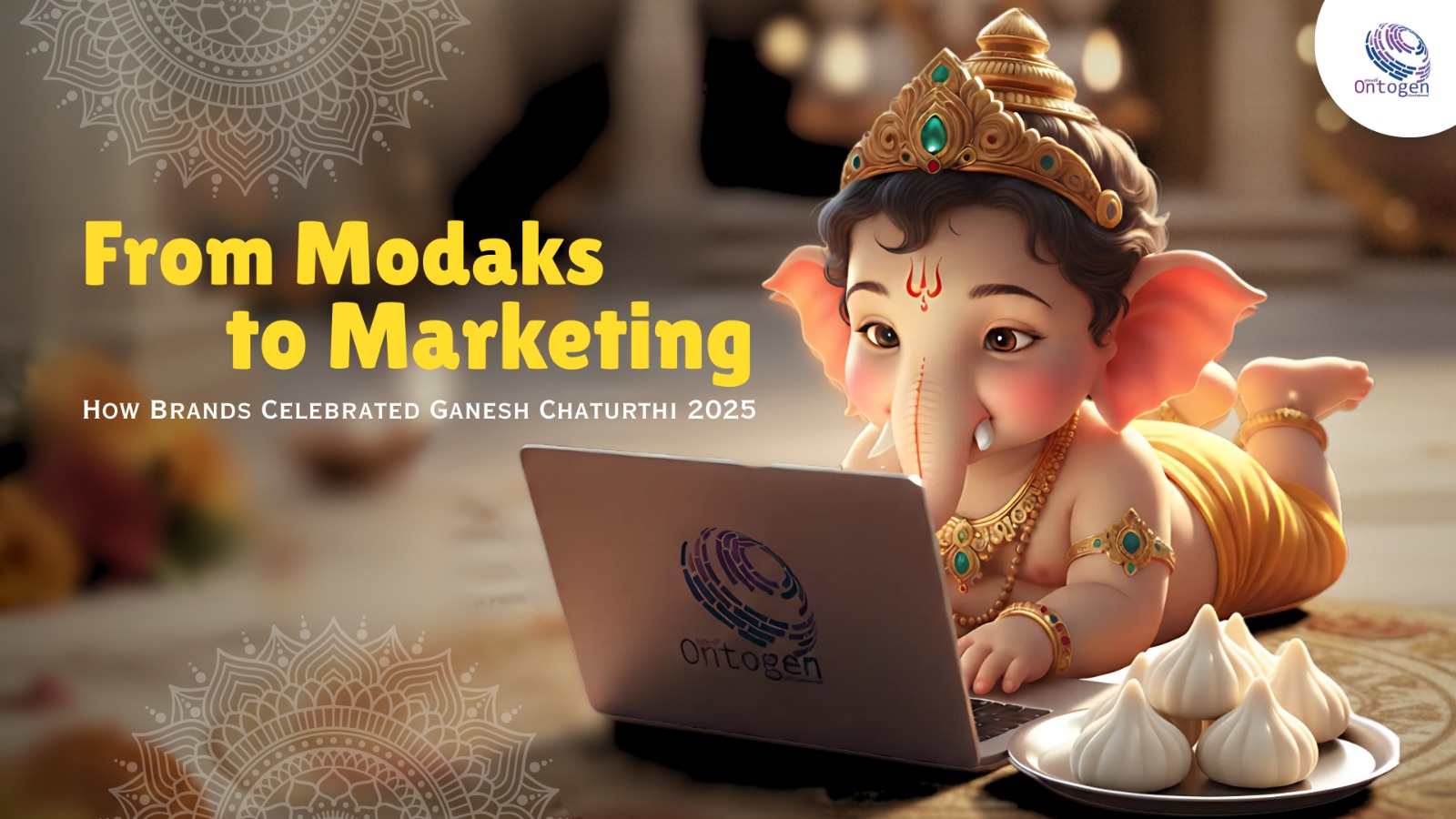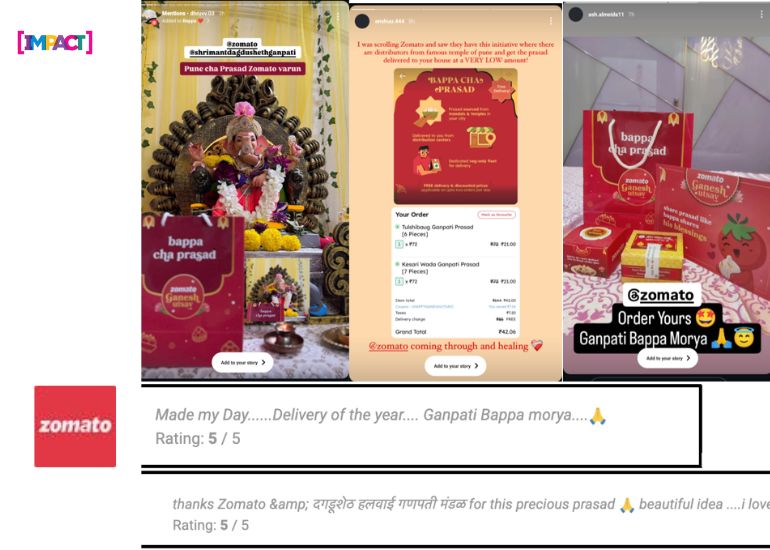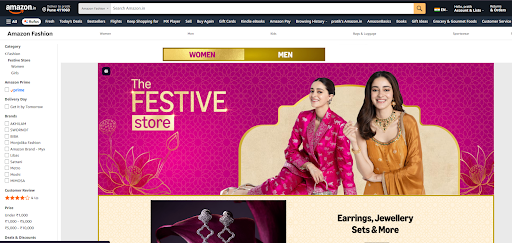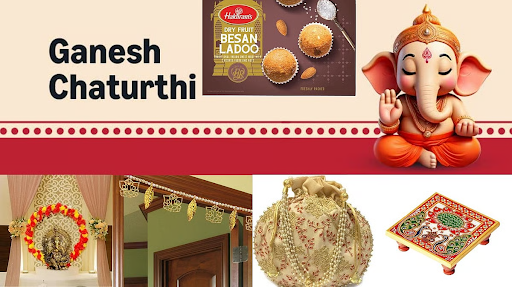
Ganesh Chaturthi has always been more than just a festival. For millions of families across India, it is a time of devotion, community, food, and togetherness. The sound of morning aartis, the fragrance of fresh flowers, and the taste of homemade modaks fill homes with warmth. But beyond the rituals, Ganesh Chaturthi also reflects something deeper; it is about creating shared memories that last long after the visarjan is done.
In recent years, brands have realized that festivals are not simply moments to push discounts or flood social media with generic greetings. Instead, they represent opportunities to connect with people on a cultural and emotional level. By becoming part of these celebrations, businesses can strengthen trust and relevance in ways that no regular campaign can achieve.
In 2025, this shift became clearer than ever. Instead of limiting themselves to festive wishes, brands across industries, from food delivery to automobiles; designed campaigns that blended tradition with modern convenience, emotion with utility, and storytelling with data. Some partnered with local communities, some solved small but real festive challenges, while others created heartwarming stories that resonated with families across the country.
This blog takes a closer look at how brands celebrated Ganesh Chaturthi in 2025. From Zomato’s devotional delivery to MG Motor’s storytelling film, we’ll explore what worked, why it mattered, and what businesses of all sizes can learn from these campaigns.
Ganesh Chaturthi as a Marketing Moment
To understand why brands invest so heavily in Ganesh Chaturthi campaigns, you need to look at the cultural and social importance of the festival. Ganesh Chaturthi is celebrated widely in Maharashtra, Karnataka, Goa, Andhra Pradesh, and many other states, but its influence has spread across India and even abroad. It is not only about devotion but also about family gatherings, neighborhood celebrations, and community participation.
For marketers, this means one thing: consumer attention peaks during festivals. Families are buying sweets, idols, clothes, decorations, and gifts. They are ordering food, planning community events, and looking for small conveniences that can make their celebrations easier. This creates a perfect space for brands to step in not just to sell, but to become a part of the festival itself.
But here’s the challenge: consumers today are more aware than ever. They can easily tell the difference between a brand that is genuinely trying to add value to their festive experience and one that is simply trying to push products. That’s why the campaigns that stood out in 2025 had one common trait: they respected tradition while making it more accessible, meaningful, or enjoyable for modern families.
Whether it was Zomato helping devotees get prasad delivered, Amazon creating a one-stop festive store, or ITC solving small problems through WhatsApp-enabled tools, each campaign showed that success comes not from flashy promotions but from understanding what people actually need during the festival.
For small businesses, startups, and ecommerce brands, this holds an important lesson: you don’t need a massive budget to stand out during festivals. What you need is empathy, creativity, and the ability to connect your product or service to the cultural fabric of the celebration.

Zomato: From Delivery to Devotion
For years, Zomato has been known for its quirky social media posts and lightning-fast food delivery. But in 2025, the brand decided to go beyond simply dropping food at people’s doorsteps. During Ganesh Chaturthi, Zomato asked itself: How can we add real value to the way families celebrate this festival? The answer was simple yet powerful: deliver not just meals, but devotion.
Partnering With Mandals
In major cities like Mumbai and Pune, Ganpati mandals play a central role in the celebrations. They are community hubs where thousands of devotees gather to pray, perform aartis, and share prasad. Zomato stepped in to make this tradition more accessible by partnering with select mandals and offering prasad delivery through its app. For many families who couldn’t attend in person — whether due to distance, health, or work — this small step made them feel connected to the festival in a meaningful way.
Modaks at Scale
Of course, Ganesh Chaturthi is incomplete without modaks, the sweet dumplings believed to be Lord Ganesha’s favorite. Zomato tapped into this cultural cornerstone by curating over 10 different varieties of modaks, available in traditional sets of 11 and 21. The offerings ranged from the classic Ukadiche Modak to modern twists like chocolate and dry fruit versions.
The numbers tell the story of how successful this was:
• At the festival’s peak, 58 boxes of modaks were ordered every minute.
• The Ukadiche Modak alone accounted for nearly 40% of total sales, showing that while innovation is welcome, tradition still leads the way.
Beyond Transactions
What made this campaign stand out was not the sales volume alone, but the way Zomato turned ordinary transactions into moments of cultural connection. Ordering food online is routine for most urban families, but ordering prasad or a festive sweet box during Ganesh Chaturthi carried an entirely different emotional weight. Zomato effectively showed that convenience doesn’t have to be transactional — it can be devotional too.
Read also: Why Your Business Needs a Professional Marketing Partner in 2025
Lessons for Marketers
For businesses of all sizes, Zomato’s campaign highlights a few important takeaways:
• Anchor your offering in tradition. Instead of pushing generic discounts, Zomato linked its service to a deeply rooted ritual — modaks and prasad.
• Think about accessibility. Many families couldn’t attend mandals physically, but still wanted to be part of the celebrations. Zomato solved this gap.
• Balance tradition with variety. The classic Ukadiche Modak led the sales, but having modern variations helped appeal to younger customers.
This campaign wasn’t just about sweets or delivery — it was about meeting people where their emotions already were. That’s why it resonated far more than a festive greeting on social media ever could.
Amazon India: A One-Stop Festive Store
If Zomato’s Ganesh Chaturthi campaign was about connecting people with tradition, Amazon India’s approach was about making celebrations simpler, bigger, and more accessible. The e-commerce giant knew that for millions of households, the festival is not only about devotion but also about preparation — decorations, puja items, sweets, outfits, and gifts. And often, managing all of this can feel overwhelming. Amazon positioned itself as the one-stop festive store where everything Ganesh Chaturthi-related could be found in a single place.

Creating a Festive Hub
Instead of promoting random offers, Amazon curated a special Ganesh Chaturthi section on its app and website. This was not just a list of products, but a well-structured journey for customers:
• Puja essentials like idols, lamps, modak moulds, and flowers.
• Decor items such as torans, rangoli sets, fairy lights, and eco-friendly décor.
• Food and sweets, including ready-to-cook modak kits and traditional mithai hampers.
• Gift options, from personalized hampers to instant e-gift cards.
The experience was designed so that even someone new to organizing the festival could find everything they needed without running from shop to shop.
Supporting Eco-Friendly Choices
One of the standout elements of Amazon’s campaign was its focus on eco-friendly idols and décor. With growing concerns about pollution caused by plaster of Paris (PoP) idols, Amazon highlighted clay idols, seed-based idols, and natural colors for decorations. This not only met a rising consumer demand but also showed social responsibility, which struck a chord with urban families who wanted to celebrate in a more sustainable way.
Read also: How Small Businesses Can Compete With Big Brands Online
The Power of Convenience
Festivals are joyful, but the preparation often brings stress — standing in long lines, sourcing from multiple vendors, or managing last-minute shortages. Amazon leveraged its strength in logistics and fast delivery to remove the stress factor. Same-day and next-day delivery options ensured that people could still prepare for the festival even if they started shopping just a day before.
This focus on reliability made Amazon not just a store, but a problem solver during a busy festive season.
Data-Driven Results
While numbers weren’t openly disclosed, industry reports suggested that Amazon’s festive campaign saw:
• A spike in first-time shoppers who were drawn by the curated festive section.
• Higher average order values, as customers often bought bundles (idols + decoration + sweets) instead of individual items.
• Strong growth in tier-2 and tier-3 cities, where access to all festive items locally is limited.
Lessons for Marketers
Amazon’s Ganesh Chaturthi approach offers practical takeaways for other businesses:
• Bundle experiences, not just products. Amazon didn’t just sell items — it offered an end-to-end festival solution.
• Highlight responsibility. The eco-friendly positioning made Amazon look like a brand that cares about cultural and environmental needs.
• Leverage your strength. Amazon’s biggest asset is its logistics. By using fast delivery as a differentiator, it turned convenience into a key festive value.
In short, Amazon didn’t just sell things during Ganesh Chaturthi — it reduced the burden of celebration planning, making customers remember it as a brand that simplified their festival, not just one that offered discounts.
Coca-Cola: Refreshing Togetherness
Festivals in India are not just about rituals; they’re about people coming together with family, friends, neighbors, even strangers who meet at pandals. Coca-Cola tapped into this spirit with its “Refreshing Togetherness” campaign during Ganesh Chaturthi 2025. Instead of focusing on discounts or pushing product features, Coca-Cola reminded people that festivals are best enjoyed when shared.
The Heart of the Campaign
The brand released a short film where families were seen preparing for Ganesh Chaturthi: arranging flowers, setting up decorations, cooking sweets, and welcoming guests. The highlight was not just the food or the festivities, but the way every moment felt warmer and more connected when shared over small conversations and a bottle of Coke.
The message was simple: “It’s not about what you celebrate with, but who you celebrate with.”
Why It Worked
• Emotional Connection Over Commercial Appeal
Instead of shouting offers or new packaging, Coca-Cola chose to remind people of shared emotions. This is what made the campaign memorable; it didn't feel like an ad, it felt like a reminder of family values.
• Aligning With the Occasion
In Ganesh Chaturthi, meals and sweets hold great importance. Coke positioned itself as the refreshing companion to these meals, sliding into the cultural context naturally rather than forcefully.
• Broad Appeal Across Age Groups
Whether it was grandparents sipping alongside their grandchildren, or youngsters enjoying it with friends after visarjan, the campaign showed Coke as a unifier across generations.
• On-Ground Activation
Coca-Cola didn’t stop at just the film. In key cities like Mumbai and Pune, the brand set up chilled Coke kiosks near Ganesh pandals, offering free drinks to devotees. This wasn’t just product sampling, it was a gesture that built goodwill.
For many families standing in long queues for darshan, that small act of receiving a cold drink felt thoughtful. It aligned perfectly with Coca-Cola’s promise of refreshment.
Measurable Impact
Industry insights suggested:
• Higher visibility in tier-1 cities, where pandal visits see huge footfall.
• Strong social media buzz, as people posted stories of enjoying Coke with family during the festival.
• Positive brand recall, with consumers associating Coke not just as a beverage, but as a part of their festive gatherings.
Lessons for Marketers
Coca-Cola’s campaign shows how brands can connect with cultural moments without overselling:
• Keep the message simple. “Togetherness” was the core idea, and everything tied back to it.
• Make the product blend in naturally. Coke didn’t try to compete with modaks or traditional sweets; it complemented them.
• Give back to the community. The free kiosks created real experiences, not just ad impressions.
In the end, Coca-Cola reminded marketers of one timeless truth: people may forget the exact ad or tagline, but they never forget how a brand made them feel.
Zepto: Bengaluru’s Sweet Tooth
Zepto saw record orders in Bengaluru, where 25% of all sweet orders during the festival came from the city. Ready-made modaks rolled out at 1,500 units per hour, while flowers and pooja items doubled in demand.

By tracking regional spikes and acting on them, Zepto showed how data-led agility makes festive campaigns impactful.
What This Means for Marketers
Ganesh Chaturthi 2025 was more than just another festival season; it was a masterclass in how brands can become part of cultural conversations. When we look across campaigns from Zomato, Amazon, Zepto, MG Motor, ITC Aashirvaad, Sunny Cooking Oil, and Coca-Cola, a few clear lessons stand out. These lessons go beyond festive marketing; they are principles that apply to any campaign aiming for meaningful impact.
1. Community First, Not Just Customers
Zomato didn’t limit itself to delivering food; it delivered prasad in partnership with mandals. This small shift in perspective turned a transactional service into a cultural contribution. By embedding themselves in community traditions, Zomato made people feel like they were part of something bigger.
Takeaway: Don’t always think of your audience as “buyers.” Think of them as participants in traditions, communities, or values. If your brand can support what matters to them, loyalty will follow naturally.
2. Convenience With Tradition
Amazon’s Ganesh Chaturthi store was a reminder that modern lifestyles don’t always leave room for elaborate preparations. Families juggle work, travel, and personal commitments, yet still want to celebrate traditions with authenticity. By offering eco-friendly idols, décor, and pooja items in one place, Amazon removed the stress of last-minute shopping without diluting the cultural significance.
Takeaway: Convenience does not mean replacing traditions, it means making them easier to follow. For marketers, the opportunity lies in reducing friction while respecting culture.
3. The Power of Regional Insights
Zepto’s success in Bengaluru highlighted an important point: festivals may be celebrated nationwide, but local preferences shape demand. Modaks dominated in Maharashtra, while Bengaluru showed a stronger appetite for sweets and flowers. By tracking these spikes, Zepto could quickly respond and capture the moment.
Takeaway: Marketing that treats India as a single block misses opportunities. Tailoring campaigns to regional behaviors makes them more relevant, and more likely to succeed.
4. Storytelling That Connects Emotionally
MG Motor’s film worked because it told a story families could instantly relate to. A child imagining Ganpati fitting into the car boot wasn’t about horsepower or design, it was about how products fit into people’s lives. Similarly, Sunny Cooking Oil’s “Letter to Bappa” touched hearts by showing how celebrations unite both cities and villages.
Takeaway: Emotional stories outlast specifications. Campaigns that make people smile, cry, or reflect will stay in memory far longer than ones that simply list features.
5. Solving Real Festive Challenges
ITC Aashirvaad’s campaign stood out for solving small but meaningful problems like not having the right aarti version on hand. By providing multilingual booklets through WhatsApp, they added value where it was genuinely needed. Instead of just pushing products, they made celebrations smoother.
Takeaway: If you want your brand to feel useful, ask: “What problem can we solve this festive season?” Sometimes it’s not about discounts, but about helping people celebrate better.
6. Blending Product With Experience
Coca-Cola’s campaign worked because it naturally slid into the festive context. It didn’t try to compete with modaks, laddoos, or family meals; it simply complemented them. And by setting up kiosks at pandals, Coke moved from being a drink in stores to an experience during the festival.
Takeaway: Marketing isn’t only about selling products it’s about creating experiences. If your product can become part of a memory, it will outlast the festival season.
7. Authenticity Over Hype
One theme across the most successful campaigns was authenticity. Whether it was Amazon supporting eco-friendly idols, Zomato partnering with mandals, or Sunny Cooking Oil highlighting cultural bonds, the efforts felt genuine. None of these brands forced a connection; they found natural links to the festival.
Takeaway: Audiences today can spot inauthentic campaigns instantly. If your festive campaign feels opportunistic instead of thoughtful, it won’t connect. Be honest, be simple, and align with the festival in a way that feels natural.
The Bigger Picture
Ganesh Chaturthi 2025 showed that festive campaigns are not just about sales spikes, they're about brand-building. People don’t remember who offered the highest discount, but they do remember who made their celebrations easier, warmer, or more joyful.
For marketers, the message is clear:
- Join the culture, don’t just advertise during it.
- Solve real problems, not just seasonal targets.
- Focus on community, not only conversions.
At Ontogen Digital, we believe every festival is an opportunity for brands to create connections that outlive the occasion. Whether it’s Diwali, Eid, or Ganesh Chaturthi, the goal should be the same: to respect traditions, ease challenges, and spark emotions that people remember.
Final Thoughts: What Ganesh Chaturthi 2025 Teaches Us
Ganesh Chaturthi has always been a festival of devotion, food, and family. But in 2025, it also became a stage for brands to show how marketing can feel less like promotion and more like participation. From Zomato bringing prasad to doorsteps, to ITC Aashirvaad solving last-minute festive stress, to Sunny Cooking Oil reminding us that food connects people, these campaigns stood out not because of their budgets, but because of their thoughtfulness.
The lesson is clear: successful festive marketing is not about pushing offers, but about creating value, easing challenges, and sparking emotions. When brands join culture with respect and empathy, people remember them long after the festival ends.
At Ontogen Digital, this is exactly how we approach marketing for businesses. We believe that campaigns should feel personal, practical, and purposeful — not forced. Whether it’s through social media storytelling, ads, or community-driven campaigns, our goal is always to help businesses connect with people in ways that matter.
If you’re a small business, startup, or growing brand wondering how to plan campaigns that go beyond discounts and likes, we’d love to help. Festivals like Ganesh Chaturthi show us that marketing works best when it feels human.
Ready to create campaigns that connect with culture, not just commerce?
Visit us at ontogendigital.com or connect with us on LinkedIn. Let’s start building marketing strategies that don’t just reach audiences but stay with them.